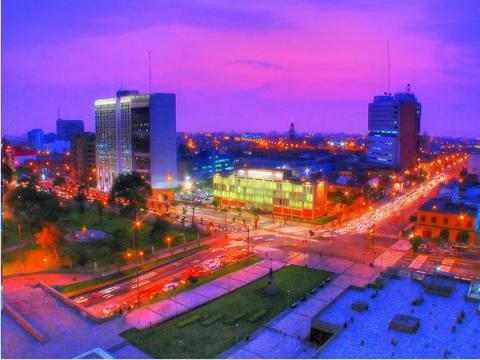Lima, Peru: The Gastronomy Capital of South America

Herman Melville’s famous character Ishmael, from Moby Dick, called Lima “The strangest, saddest city thou can’st see.” Probably referring to the hazy veil that hovers over the city. Forget Melville. Lima is a city of rich history, culinary extravagance, and beautiful parks and gardens. The architecture is a mix of Baroque and Renaissance style.
With more than 9 million people, Lima is the largest city of Peru. It is located on the coast of the Pacific Ocean, offering beautiful beaches and a stunning landscape. Lima is the first stop for people on the way to Cuzco and then the legendary Inca ruin Machu Picchu.
One of the most popular places to stay is Mira Flores, an upscale area with plenty of restaurants and shopping. Here you can find the Inca Markets, showcasing all the local goods and textiles. Keep an eye out for a real Alpaca blanket, one of the softest in the world. Alpaca’s are famous for their soft hair, and are prized for being used in clothing. The first cut of a baby Alpaca is the most prized and expensive.
From here it is a pleasant walk through the area to Huaca Pucllana, an ancient ruin dating back to 400 AD. This is the biggest and oldest ruin in the city. A pyramid stands in the middle. English guided tours are offer insight into the culture of the indigenous people and , how they lived. You can walk through the flora and fauna park and up to a great view of Lima from the top of the hill. There is a wonderful restaurant here to dine in that overlooks the ruins. But if you want the national dish, ceviche, head down the road.
Ceviche is the famous Peruvian addition to the culinary world, raw fish and seafood cured in citrus and served cold, absolutely delicious and refreshing to eat. For this treat head to La Red, a favorite of locals. The restaurant is well known and busy. Now try another Peruvian favorite, the national drink, Pisco Sour. Pisco is a grape brandy liquor, which is mixed with beaten egg whites and bitters.
Try a coca leaf pisco sour. These are made with the coca leaves, which is the plant that cocaine is made from. The leaves in Peru have been used for centuries in teas for medicinal purposes and for altitude sickness; if you go to Cuzco and Macchu Picchu they will advise you to chew these.
Brujas de Cachiche is another great stop. Indulge at the excellent Pisco bar and this gorgeous restaurant that offers a fusion between Peruvian and international cuisine. With a wide array of restaurants, it is easy to see why Lima is known as the gastronomy capital of South America.
Parque Kennedy is a popular, central area in Mira Flores. Here you can find everything—restaurants, bars, a market in the park, artists lining the streets, and locals milling about – an ideal location for people watching.
It’s a short taxi ride to Parque de Amor, here you can stroll along the Cliffside de Chorrillos and enjoy breathtaking views of the Pacific Ocean. But first notice the famous Lima landmark of a man and a woman in a romantic embrace, showing why Lima is recognized as a city for lovers. Romance is abundant and appreciated in Lima, which is accompanied by the many parks and fountains in the city. At night it is a city of lights with all the lighted parks and fountains.
Head down one of the stairways to the beaches below, where many hotels and country clubs line the roads. The beaches are picturesque and charming. One can’t help notice the pier jutting out into the ocean. At the end is the world-renowned restaurant La Rosa Nautica, a high-end restaurant with great views and equally great food.
To visit the center of the city start at Plaza San Martin, which is a popular tourist spot, as, people like to hang around the statue and then stroll down the pedestrian pathway that will take you through an outdoor bazaar. Shops, restaurants, and clubs line the streets. There are many restaurants that serve pit-roasted chicken, a delicious snack or meal. At the end you will be at the main square of Lima, known as Mayor Square or Plaza de Armas, the lively heart of the city. Only a little farther past the square is the river, where along the river bank are dozens of food stalls serving local fare like grilled heart and intestines.
As night begins to set in it is time to head to the stunning Parque de Reserve, the world’s biggest fountain complex where 13 water fountains put on an amazing display of entertainment. The fountains shoot water to music and lights, some are interactive and you can walk under the shooting streams of water. In the center is the Magical Fountain, where a huge water and light show is a must see.
For a taste of Lima nightlife, head to Barranco, which boasts a slew of bars and clubs. Walk down Carrion Street where club owners stand outside and try to entice you to come in. At some point take a walk across the lighted bridge on the other side of Municipal Park.
A couple of days in this jewel of South America will leave most visitors craving for more and counting the days until their next return.
Author Bio:
Stephen Delissio is a contributing writer at Highbrow Magazine.
For Highbrow Magazine
Photos: Rafael Mastunaga (Wikipedia.org, Creative Commons); Mira4espina78y (Wikipedia, Creative Commons);

































































































































































































































































































































